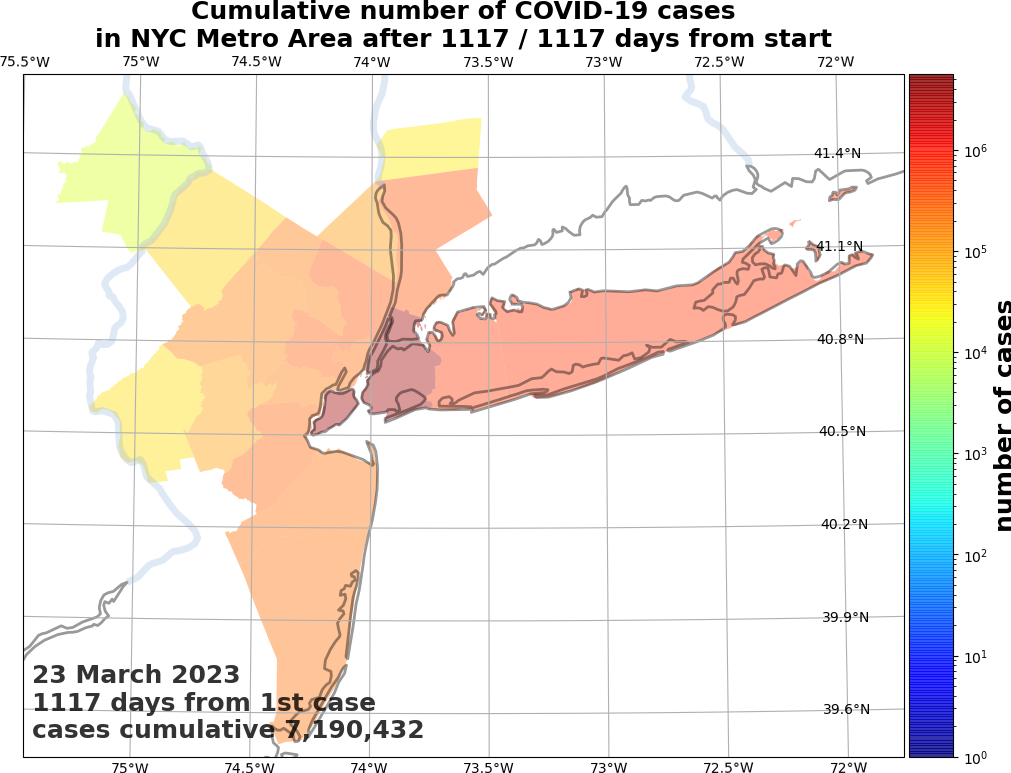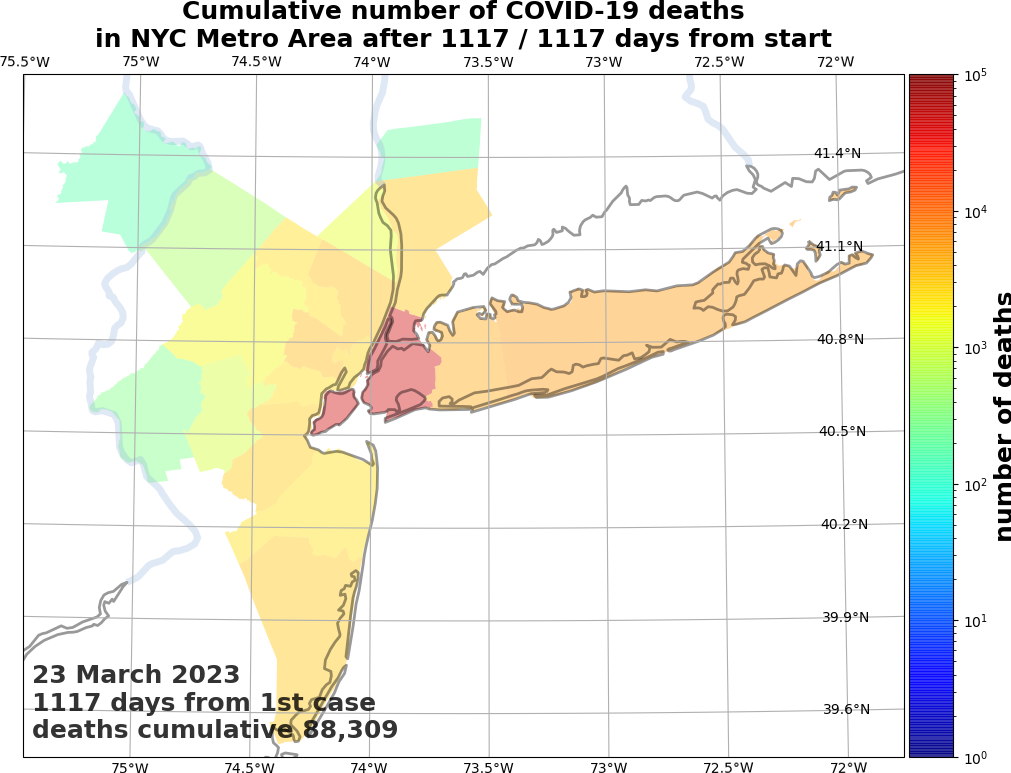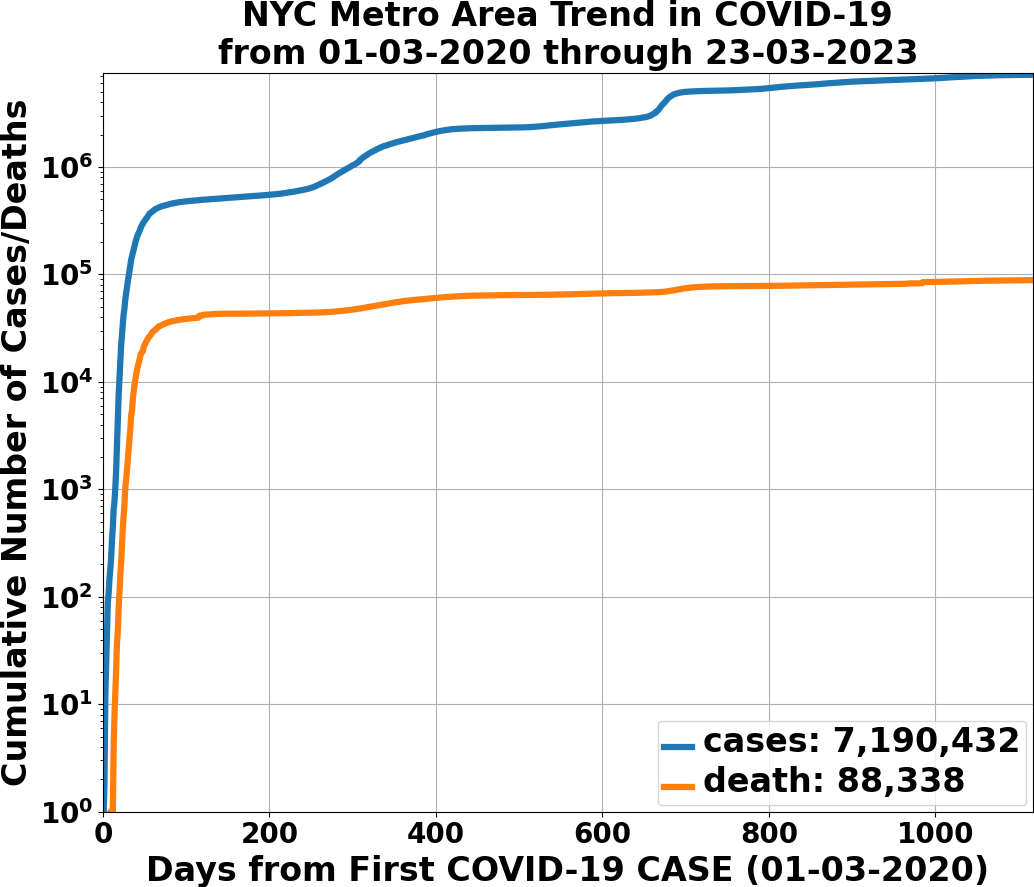4.5. covid19_stats.engine.viz module
This module provides visualization methods for COVID-19 cumulative cases and deaths for MSAs, states, and the CONUS. These command line interfaces – covid19_create_movie_or_summary, covid19_state_summary, and covid19_movie_updates – are front-ends to the methods in this module.
- covid19_stats.engine.viz.create_and_draw_fromfig(fig, bbox, river_linewidth=5, river_alpha=0.3, coast_linewidth=2, coast_alpha=0.4, drawGrid=True, mult_bounds_lat=1.05, mult_bounds_lng=1.05, rows=1, cols=1, num=1)
This creates an
GeoAxes, with lots of physical geographic features, and optional (but turned on by default) latitude and longitude gridding, of a region specified by a bounding box. This uses stereographic projection. For example, here is theGeoAxesdisplaying the CONUS.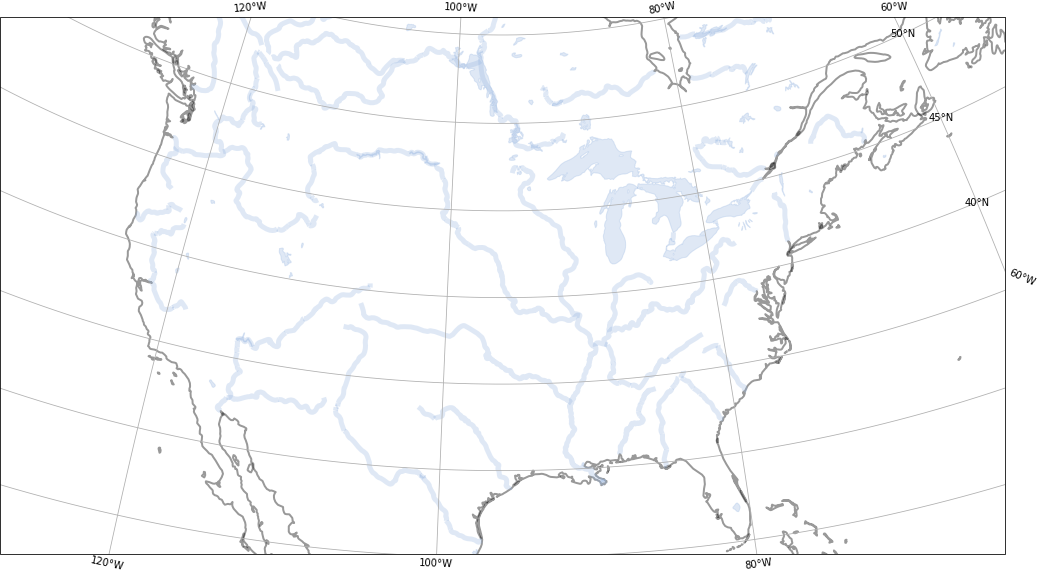
Fig. 4.4 Demonstrations of this functionality, which underlies (or overlays?) the geographical features for visualizing COVID-19 cases and deaths.
Here are the arguments.
- Parameters:
fig – the
Figureonto which to create aGeoAxescontaining geographic features. Last three arguments –rows,cols, andnum– describe the relative placement of the createdGeoAxes. Seeadd_subplotfor those three arguments’ meanings.bbox (tuple) – a four-element
tuple. Elements in order are minimum longitude, minimum latitude, maximum longitude, and maximum latitude.river_linewidth (int) – the width, in pixels, of river geographical features.
river_alpha (float) – the color alpha of river geographical features.
coast_linewidth (int) – the width, in pixels, of the coast lines.
coast_alpha (float) – the color alpha of coast lines.
drawGrid (bool) – if
True, then overlay the latitude and longitude grid lines. Otherwise do not. Default isTrue.mult_bounds_lat (float) – often times, especially with geographic regions that cover a significant area of the earth, we need to put a multiplier \(> 1\) on the latitudinal extent of the plot, so that all features can be seen. By default this value is 1.05, but it must be \(\ge 1\).
mult_bounds_lng (float) – often times, especially with geographic regions that cover a significant area of the earth, we need to put a multiplier \(> 1\) on the longitudinal extent of the plot, so that all features can be seen. By default this value is 1.05, but it must be \(\ge 1\).
rows (int) – the number of rows for axes in the
Figuregrid. Must be \(\ge 1\), and by default is 1.cols (int) – the number of columns for axes in the
Figuregrid. Must be \(\ge 1\), and by default is 1.num (int) – the plot number of the
GeoAxesin thisFiguregrid. Must be \(\ge 1\) and \(\le\)rowstimescolumns. Its default is 1. Look atadd_subplotfor its meaning.
- Return type:
- covid19_stats.engine.viz.create_plots_daysfrombeginning(inc_data, regionName, prefix, days_from_beginning=[0], dirname='/usr/WS2/islam5/covid19_stats/docsrc')
Creates a collection of quad PNG images (see Section 3.2.3 or Section 3.3.2) representing state of cumulative COVID-19 cases and deaths for a geographical region. Like movie mode in covid19_create_movie_or_summary or state movie mode, the four quadrants are,
upper leftis the summary information for the geographical region.lower leftis the running tally of cumulative cases and deaths, by day from first incident.upper rightis the logarithmic coloration of cumulative deaths, by day from first incident.lower rightis the logarithmic coloration of cumulative cases, by day from first incident.
create_summary_movie_frombeginninguses this functionality in a multiprocessing fashion to create MP4 movie files for geographical regions. It is easier to show rather than tell. Fig. 4.5 is a quad plot of cumulative COVID-19 cases and deaths for the NYC metro area, 150 days after this metro’s first COVID-19 incident, that is created by this function.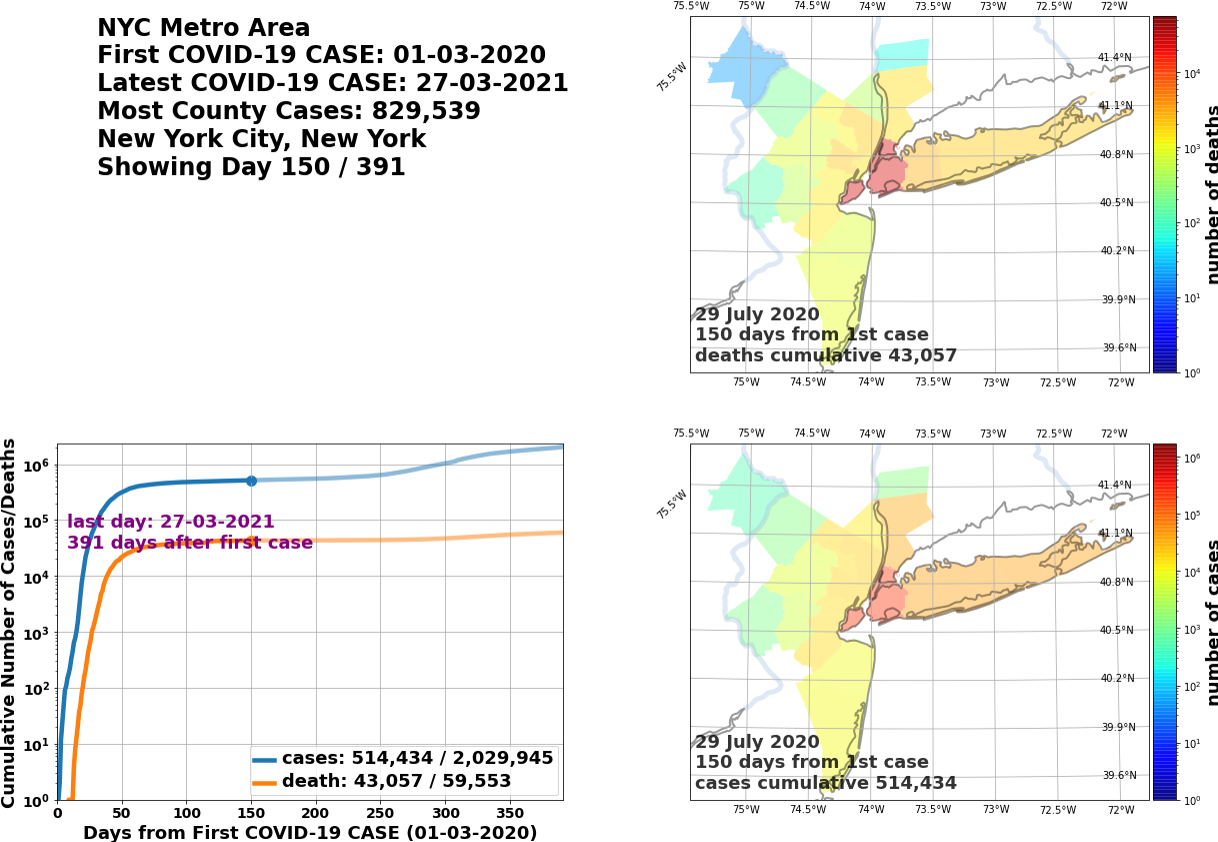
Fig. 4.5 Quad plot of cumulative COVID-19 cases and deaths for the NYC metro area, 150 days after its first incident. The name of the file is
covid19_nyc_LATEST.0150.png.The collection of PNG images that this method creates are auto-cropped and, where needed, resized so that their widths and heights are even numbers. FFmpeg, run through
create_summary_movie_frombeginning, cannot create an MP4 from PNGs unless the images’ widths and heights are divisible by 2.- Parameters:
inc_data (dict) – the data for incidence of COVID-19 cases and deaths for a given geographical region. See
get_incident_datafor the format of the output data.regionName (str) – the name of the region to display in title plots. For example, in Fig. 4.10, this is
NYC Metro Area.prefix (str) – the identifying name to put into the output PNG files. For example, in Fig. 4.5, the
prefixisnyc, and the name of the file iscovid19_nyc_LATEST.0150.png. If the prefix isconus, then this module creates plots appropriate for geographic regions (such as CONUS) that cover significant areas of the earth’s surface.days_from_beginning (list) – the
listof days to create quad PNG images. Must be nonempty, and every element must be \(\ge 0\). Default is[ 0, ].dirname (str) – the directory into which to save the quad PNG images. The default is the current working directory.
- Returns:
the
listof filenames of PNG quad images that this method creates, intodirname. For example, in the method invocation shown in Fig. 4.5,days_from_beginning = [ 150, ], and the list this method returns is[ '<dirname>/covid19_nyc_LATEST.0150.png', ].- Return type:
- covid19_stats.engine.viz.create_summary_cases_or_deaths_movie_frombeginning(inc_data, type_disp='cases', dirname='/usr/WS2/islam5/covid19_stats/docsrc', save_imgfiles=False)
This is the back-end method for movie cases deaths mode for covid19_create_movie_or_summary, and state movie cases deaths mode for covid19_state_summary. This creates an MP4 movie file of cumulative COVID-19 cases or deaths, with identifying metadata, for a given geographical region. Table 4.1 shows the resulting MP4 movie files, of cumulative COVID-19 cases and deaths, for the NYC metro area (top row), and the state of Virginia (bottom row).
Table 4.1 Latest cumulative COVID-19 cases, and deaths, for the NYC metro area and Virginia NYC metro area, latest movie of COVID-19 cumulative cases
NYC metro area, latest movie of COVID-19 cumulative deaths
Virginia, latest movie of COVID-19 cumulative cases
Virginia, latest movie of COVID-19 cumulative deaths
Here are the arguments,
- Parameters:
inc_data (dict) – the data for incidence of COVID-19 cases and deaths for a given geographical region. See
get_incident_datafor the format of the output data.type_disp – if
cases, then show cumulative COVID-19 cases. Ifdeaths, then show cumulative COVID-19 deaths. Can only becasesordeaths.dirname (str) – the directory into which to save the MP4 movie file, and optionally a zip archive of the PNG image files used to create the MP4 movie. The default is the current working directory.
save_imgfiles (bool) – if
True, then will create a zip archive of the PNG image files used to create the MP4 movie. Its full name is<dirname>/covid19_<prefix>_<type_disp>_LATEST_imagefiles.zip.<dirname>is the directory to save the MP4 file,<prefix>is the region name prefix (for examplenycfor the NYC metro area) located ininc_data['prefix'], and<type_disp>is eithercasesordeath. The default isFalse.
- Returns:
the base name of the MP4 movie file it creates. For example, if
inc_data['prefix']isnycandtype_dispiscases, this method returnscovid19_nyc_cases_LATEST.mp4. This method also saves the MP4 file as<dirname>/covid19_nyc_cases_LATEST.mp4, where<dirname>is the directory to save the MP4 file.- Return type:
- covid19_stats.engine.viz.create_summary_movie_frombeginning(inc_data, dirname='/usr/WS2/islam5/covid19_stats/docsrc', save_imgfiles=False)
This is the back-end method for movie mode for covid19_create_movie_or_summary, and state movie mode for covid19_state_summary. This creates an MP4 quad movie file of both cumulative COVID-19 cases and deaths for a geographical region, and optionally a zip archive of PNG images used to create the MP4 file. This uses
create_plots_daysfrombeginningin a multiprocessing fashion, to create sub-collections of PNG quad images, and then collate them into an MP4 file using FFmpeg. Table 4.2 shows the resulting MP4 movie files, of cumulative COVID-19 cases and deaths, for the NYC metro area and the state of Virginia.Table 4.2 Latest cumulative quad movies of COVID-19 for the NYC metro area and Virginia NYC metro area, latest quad movie of COVID-19 cumulative cases and deaths
Virginia, latest quad movie of COVID-19 cumulative cases and deaths
Here are the arguments,
- Parameters:
inc_data (dict) – the data for incidence of COVID-19 cases and deaths for a given geographical region. See
get_incident_datafor the format of the output data.dirname (str) – the directory into which to save the MP4 movie file, and optionally a zip archive of the PNG image files used to create the MP4 movie. The default is the current working directory.
save_imgfiles (bool) – if
True, then will create a zip archive of the PNG image files used to create the MP4 movie. Its full name is<dirname>/covid19_<prefix>_LATEST_imagefiles.zip.<dirname>is the directory to save the MP4 file, and<prefix>is the region name prefix (for examplenycfor the NYC metro area) located ininc_data['prefix']. The default isFalse.
- Returns:
the base name of the MP4 movie file it creates. For example, if
inc_data['prefix']isnyc, this method returnscovid19_nyc_LATEST.mp4. This method also saves the MP4 file as<dirname>/covid19_nyc_LATEST.mp4, where<dirname>is the directory to save the MP4 file.- Return type:
- covid19_stats.engine.viz.display_fips(collection_of_fips, fig, **kwargs)
Method that is very similar to
display_fips_geom, except this also displays the FIPS code of each county. For example, for Rhode Island, this is.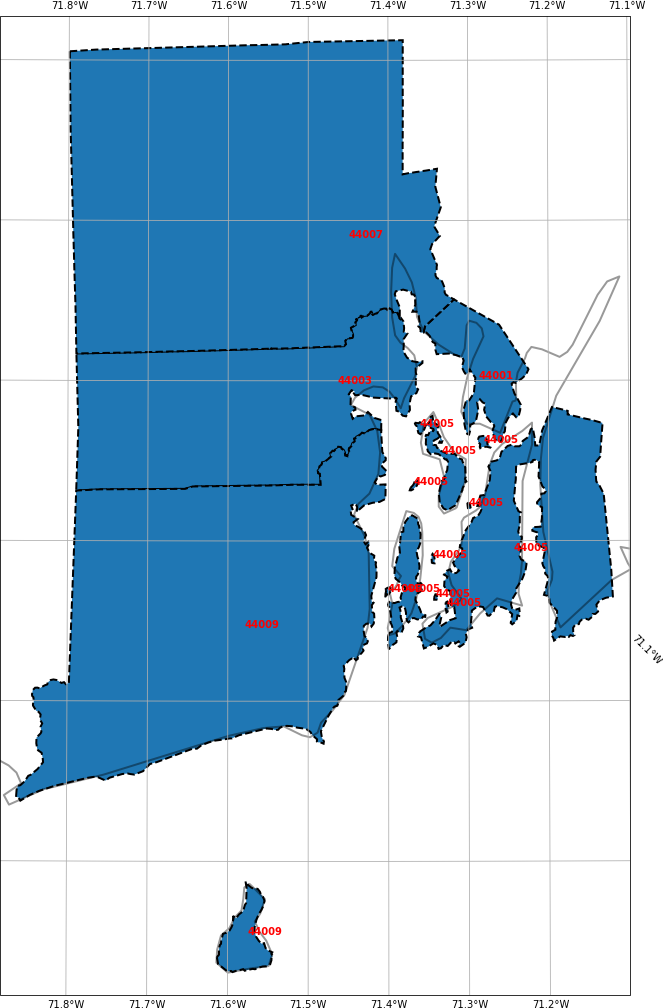
Fig. 4.6 Demonstration of this method showing the counties in Rhode Island. The FIPS code of each county is shown in red. One can extract the patches in this object to manually change the colors of these county polygons.
Here are the arguments.
- covid19_stats.engine.viz.display_fips_geom(fips_data, fig, **kwargs)
Demonstrative plot, returning a
GeoAxes, of a FIPS data collection. For example, for the NYC Metro Area, this is,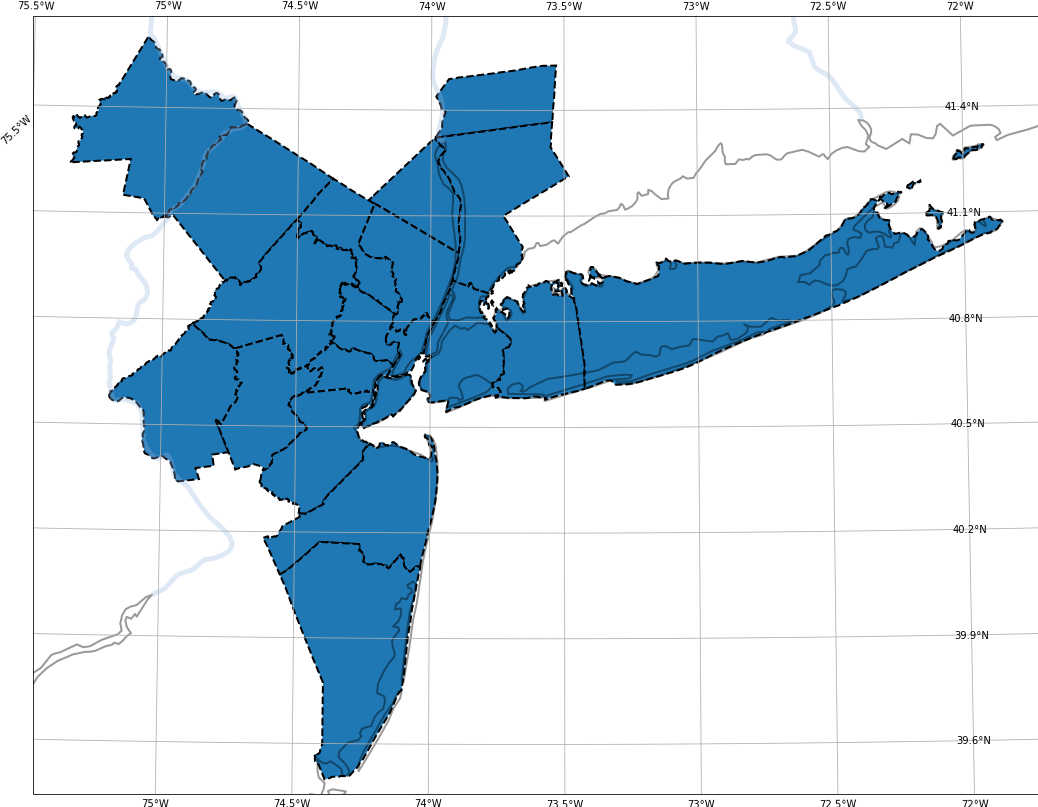
Fig. 4.7 Demonstration of this method showing the counties in the NYC Metro Area. One can extract the patches in this object to manually change the colors of these county polygons.
Here are the arguments.
- covid19_stats.engine.viz.display_msa(msaname, fig, doShow=False, **kwargs)
Convenience method that visualizes and labels, by FIPS code, the counties in a Metropolitan Statistical Area. It can optionally save the output to a file,
msa_<msaname>_counties.png. Here is an example of the NYC Metro Area.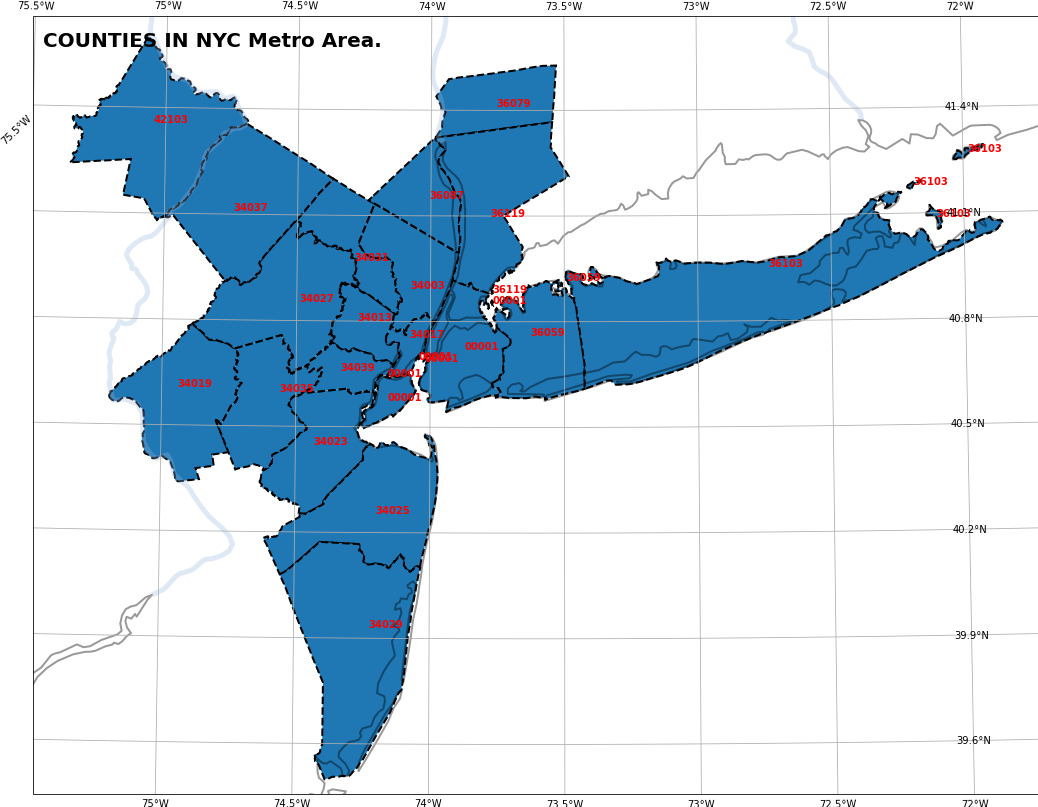
Fig. 4.8 Display of the NYC Metro Area, with extra annotations beyond what
display_fipscan do.Here are the arguments.
- covid19_stats.engine.viz.get_summary_demo_data(inc_data, dirname='/usr/WS2/islam5/covid19_stats/docsrc', store_data=True)
This is the back-end method for show mode for covid19_create_movie_or_summary, and state show mode for covid19_state_summary. This creates six or seven files for a given geographical region. Given an input
inc_datadict, it produces six files by default. Hereprefixis the value ofinc_data['prefix'](for examplenycfor the NYC metro area).covid19_<prefix>_cases_LATEST.pdfandcovid19_<prefix>_cases_LATEST.png: a PDF and PNG plot of the latest cumulative COVID-19 cases for the geographical region.covid19_<prefix>_death_LATEST.pdfandcovid19_<prefix>_death_LATEST.png: a PDF and PNG plot of the latest cumulative COVID-19 deaths for the geographical region.covid19_<prefix>_cds_LATEST.pdfandcovid19_<prefix>_cds_LATEST.png: a PDF and PNG plot of the latest cumulative COVID-19 case and death trend lines for the geographical region.
Optionally, one can choose to dump out a serialized
Pandas DataFrameof the COVID-19 cases and deaths, total and per county, from the date of first incident to the latest incident. Its file name iscovid19_<prefix>_LATEST.pkl.gz.Table 4.3 displays the latest output for the NYC metro area.
Table 4.3 Latest plots of cumulative COVID-19 cases, deaths, and trend lines for the NYC metro area NYC metro area, plot of latest COVID-19 cumulative cases
NYC metro area, plot of latest COVID-19 cumulative deaths
NYC metro area, plot of latest trend lines of COVID-19 cumulative cases and deaths
Here are the arguments.
- Parameters:
inc_data (dict) – the data for incidence of COVID-19 cases and deaths for a given geographical region. See
get_incident_datafor the format of the output data.dirname (str) – the directory into which to save the six or seven files. The default is the current working directory.
store_data (bool) – if
True, then create the serializedPandas DataFrameof the COVID-19 cases and deaths, total and per county, from the date of first incident to the latest incident. Default isTrue.
- covid19_stats.engine.viz.my_colorbar(mappable, ax, **kwargs)
secret saucing (explanation is incomprehensible) from https://joseph-long.com/writing/colorbars. I do not understand how it works the way it does, but it does! I shamelessly copy the method description from the
colorbar method. I have also updated this thing to this website that now works onGeoAxes.- Parameters:
mappable – a
ScalarMappabledescribed by this colorbar.ax – the parent
Axesfrom whose space a new colorbar axes will be stolen.
- Returns:
the underlying
Colorbar.- Return type:
- covid19_stats.engine.viz.plot_cases_deaths_region(inc_data, regionName, ax, days_from_beginning=0, doTitle=True, legend_text_scaling=1.0, aspect_ratio_mult=1.0)
Plots trend lines of cumulative COVID-19 cases and deaths for a region. It is easier to show rather than tell. Fig. 4.9 depicts trend lines of cumulative COVID-19 cases and deaths for the NYC metro area, 150 days after this metro’s first COVID-19 incident.
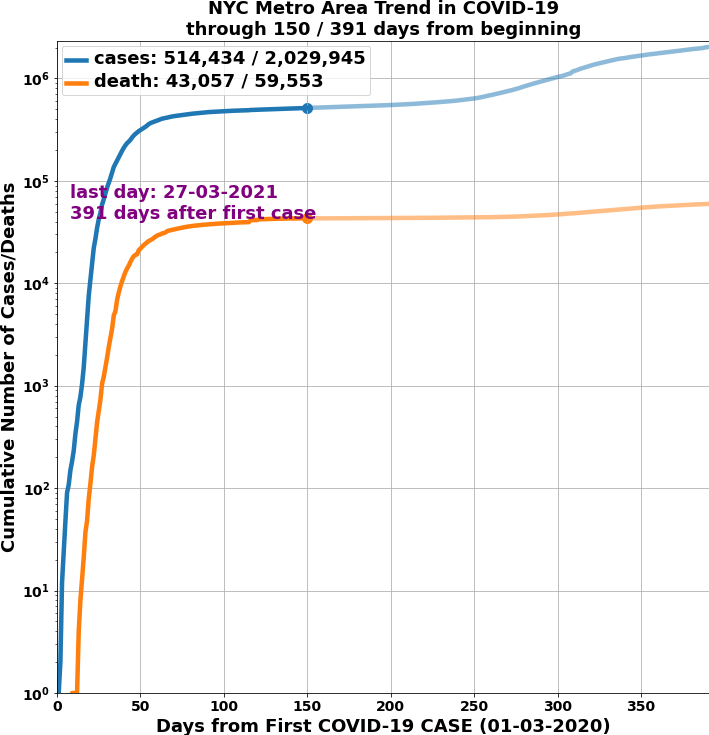
Fig. 4.9 Plot of cumulative COVID-19 cases and deaths for the NYC metro area, 150 days after its first incident. Plot scaling is logarithmic, and dots accentuate the state of the cumulative cases and deaths 150 days after first incident. We have chosen to display the title.
Here are the arguments.
- Parameters:
inc_data (dict) – the data for incidence of COVID-19 cases and deaths for a given geographical region. See
get_incident_datafor the format of the output data.regionName (str) – the name of the region to display in title plots. For example, in Fig. 4.10, this is
NYC Metro Area.ax – the
Axesonto which to make this plot.days_from_beginning (int) – days after first incident of COVID-19 in this region. Must be \(\ge 0\).
doTitle (bool) – if
True, then display the title over the plot. Default isTrue.legend_text_scaling (float) – sometimes the legend text for the cumulative COVID-19 cases and deaths is too large. This is a multiplier on that text’s font size. Default is 1.0, but must be \(> 0\).
aspect_ratio_mult (float) – in the quad plots created in
create_plots_daysfrombeginningor increate_summary_movie_frombeginning, without modification theAxesmay look too squashed and inconsistent with the three otherAxesorGeoAxes. This acts as a multiplier on the aspect ratio so that thisAxesdoes not look out of place. Default is 1.0, but must be \(> 0\).
- covid19_stats.engine.viz.plot_cases_or_deaths_bycounty(inc_data, regionName, fig, type_disp='cases', days_from_beginning=0, doTitle=True, plot_artists={}, poly_line_width=1.0, legend_text_scaling=1.0, doSmarter=False, rows=1, cols=1, num=1)
The lower-level function that displays the status of COVID-19 cases or deaths given an incidident data
dict,inc_data. It displays the status of cumulative COVID-19 cases or deaths, a specific number of days from the beginning, coloring the counties in that region according to the legend maximum, and places the resultingGeoAxesat a specific location in aFiguregrid ofAxesorGeoAxes.Instead of returning a
GeoAxes, this initializes adictof matplotlib objects,plot_artists. In this way, subsequent plots, e.g. for different days after the beginnning, do not have to perform the relatively costly operation of recreating theGeoAxesand fully painting in thePolygonpatches; instead, thesePolygonpatches are re-colored and necessaryTextartists’ strings are changed.This
dict,plot_artists, has the following keys,axes: when initialized, theGeoAxesthat consists of all counties, with COVID-19 cases or deaths, to display.sm: theScalarMappabledescribing the coloration by value for each county.
Furthermore, it is easier to show rather than tell. Fig. 4.10 depicts both cumulative COVID-19 cases and deaths for the NYC metro area, 150 days after this metro’s first COVID-19 incident.
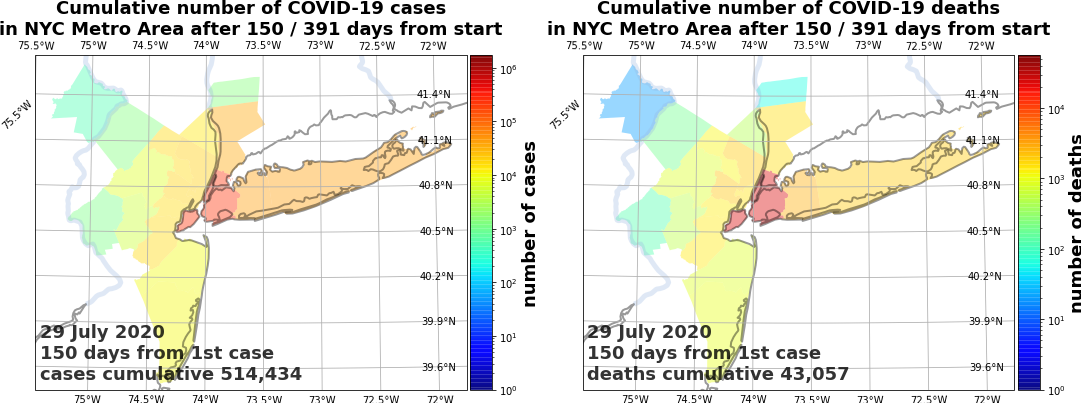
Fig. 4.10 On the left, is the COVID-19 cumulative cases, and on the right, is the COVID-19 cumulative deaths, for the NYC metro area, 150 days after its first COVID-19 incident. The color limits for cases (left) is \(1.7\times 10^6\), while the color limits for death (right) is \(5.6\times 10^4\). We have chosen to display the titles over both plots. Color scaling is logarithmic.
Here are the arguments.
- Parameters:
inc_data (dict) – the data for incidence of COVID-19 cases and deaths for a given geographical region. See
get_incident_datafor the format of the output data.regionName (str) – the name of the region to display in title plots. For example, in Fig. 4.10, this is
NYC Metro Area.fig – the
Figureonto which to create aGeoAxes(stored into theplot_artistsdict) containing geographic features. Last three arguments –rows,cols, andnum– describe the relative placement of the createdGeoAxes. Seeadd_subplotfor those three arguments’ meanings.type_disp (str) – if
cases, then show cumulative COVID-19 cases. Ifdeaths, then show cumulative COVID-19 deaths. Can only becasesordeaths.days_from_beginning (int) – days after first incident of COVID-19 in this region. Must be \(\ge 0\).
doTitle (bool) – if
True, then display the title over the plot. Default isTrue.plot_artists (dict) – this contains the essential plotting objects for quicker re-display when plotting different days. Look at this description.
poly_line_width (float) – the line width of the counties to draw in the plot.
legend_text_scaling (float) – sometimes the text annotations showing the date, number of incident days, and cumulative deaths or cases is too large. This is a multiplier on that text’s font size. Default is 1.0, but must be \(> 0\).
doSmarter (bool) – if
False, then make a plot tailored for small regions (relative to the size of the earth), such as states or MSAs. IfTrue, then make a plot tailored for large regions such as the CONUS. Default isFalse.rows (int) – the number of rows for axes in the
Figuregrid. Must be \(\ge 1\), and by default is 1.cols (int) – the number of columns for axes in the
Figuregrid. Must be \(\ge 1\), and by default is 1.num (int) – the plot number of the
GeoAxesin thisFiguregrid. Must be \(\ge 1\) and \(\le\)rowstimescolumns. Its default is 1. Look atadd_subplotfor its meaning.
